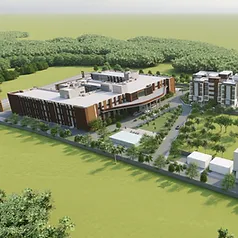Office
New Bel Road
Bangalore , Karnataka
India (560054)

Contact : +91 9632587562
Urban redevelopment refers to the process of rejuvenating or revitalizing existing urban spaces to meet contemporary needs. It often involves reimagining old, dilapidated, or underutilized areas to make them functional, vibrant, and suitable for modern living. Urban redevelopment is essential for cities experiencing population growth, aging infrastructure, and the need for sustainable development. In many cases, it transforms a city’s economic, social, and cultural landscape, making it more attractive for businesses, residents, and tourists alike.
Urban redevelopment plays a crucial role in improving the quality of life in cities. As cities expand, older areas often face neglect due to the focus on developing new regions. This can lead to urban decay, characterized by poorly maintained buildings, outdated infrastructure, and declining economic activity. Redeveloping these areas revitalizes neighborhoods by upgrading infrastructure, attracting investments, and improving social amenities such as parks, schools, and public transportation.
One of the key objectives of urban redevelopment is to create more sustainable and inclusive environments. Modern redevelopment projects often incorporate green spaces, energy-efficient buildings, and pedestrian-friendly layouts, promoting eco-friendly living. Additionally, such projects aim to provide affordable housing, addressing issues related to urban inequality. By creating a balance between residential, commercial, and recreational spaces, urban redevelopment enhances the overall livability of a city.
Mixed-Use Development: This method involves combining residential, commercial, and recreational spaces within the same area. It creates vibrant neighborhoods where people can live, work, and play, reducing the need for long commutes and promoting a sense of community. Mixed-use developments are particularly popular in urban centers where space is limited.
Transit-Oriented Development (TOD): TOD focuses on creating high-density neighborhoods around public transport hubs like metro stations or bus terminals. This strategy encourages the use of public transportation, reduces traffic congestion, and promotes sustainable urban growth.
Adaptive Reuse: Instead of demolishing old buildings, adaptive reuse transforms existing structures into new facilities. This approach preserves the historical and cultural significance of the area while providing modern amenities. For example, old factories can be converted into residential lofts or office spaces, blending the old with the new.
Public-Private Partnerships (PPP): Urban redevelopment projects often require significant investment. In many cases, local governments collaborate with private developers to fund and execute large-scale redevelopment projects. This partnership ensures the best use of resources and expertise, resulting in efficient project delivery.
Urban redevelopment is not without its challenges. One major issue is gentrification, where redevelopment can drive up property values, pushing out low-income residents and changing the social fabric of the community. Striking a balance between modernization and inclusivity is crucial to avoid exacerbating inequality.
Another challenge is funding. Redevelopment projects are often capital-intensive, requiring substantial investment from both the public and private sectors. Securing funding while ensuring affordability and accessibility for all can be a complex process.
Urban redevelopment is a vital tool for rejuvenating aging urban areas, making them more livable, sustainable, and economically vibrant. With careful planning and execution, redevelopment can address housing shortages, improve infrastructure, and promote eco-friendly living. However, it must be done in a way that includes all residents, ensuring that economic growth benefits everyone, not just a select few. As cities continue to grow, urban redevelopment will play an increasingly important role in shaping the future of urban life.